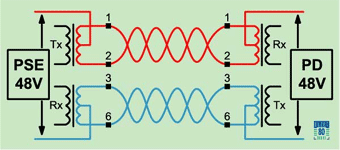Power-Over-Ethernet basics

Power-over-Ethernet is an extension to the IEEE802 standard opening the possibility to power remote nodes using the standard CAT5 data cable. Special network switches or midspan injectors provide 48V to the network. For safety reasons, a sophisticated protocol between the power source (PSE) and the powered device (PD) assures that only valid PoE PDs get their 48V. Instead of the data lines (powered as shown), the 4 extra wires of a CAT5 cable may be used for supply.
- Supplies 48V at 12,95W per unit over the Ethernet cable
- No constraints on standard CAT5 line length of 100m
- No adverse effects on non-PoE-devices, compatible with Gigabit Ethernet
- "Negotiation" phase before powering a ceratin line
- Affordable standard switches due to use in VoIP-Phones and WLAN access points.
- Ideally suited for remote sensors without mains access, typically for outdoor use or locations like cellar, shed, or attic.
- ELZET80's power supply offers additional 24V@200mA for local switches or mini-valves
- ELZET80's power supply automatically isolates ports and e.g. analog inputs
- Details
Details
PSE = Power Sourcing Equipment: e.g. Switch or "Midspan- Injector"
PD = Powered Device
Powering Ethernet devices conveniently through the network cable
The highest benefit is delivered by PoE for locations distant from mains supply such as remote corners of a factory floor or outdoor. Uninterruptible service is another domain of PoE as a UPS can easily be attached to the power source. Hence the biggest market drive comes from Voice-over-IP phones where both arguments apply: Nobody wants another wall power supply around his desk and a phone should continue to work through a power outage. In the industry, uninterruptible supplies are desirable if not mandatory for e.g. displays, gate control, emergency generator monitoring etc.
No outlet on the ceiling? Don't worry - you don't need one!
- Mounting that wireless LAN router where it delivers the best field strength isn't limited to a nearby outlet anymore. With Powerover- Ethernet it gets its power through the CAT5 cabling
- 12,95W per device (worst case)
- Electrically safe through extra-low voltage (SELV) plus stand-by negotiation
ELZET80 starts its PoE line with installation-friendly "junction boxes", for instance as gateways Ethernet to BITBUS or to RS232 plus some simple i/o to for instance a gate or an emergency generator. Built-in web servers help integrate such non-IT devices into the intranet. To make wiring really easy, the boxes are equipped with LSA connectors for CAT5 installation wire or patch cable. I/o and serial lines find rows of spring cage terminals for solid or stranded wire.
As we need 5V and 24V for our target applications, we provide some 24V, too from our own PoE power supply. While 200mA at 24V isn't really copious, it will do for some initiators and a small relay or valve.
POE24/5
This power supply uses a special circuit to handle the PoE negotiation which releases the flyback converter once it has entered PoE operation phase. It generates isolated voltages of 5V for the processor and 24V for i/o.
Making the PoE supply isolated automatically isolates the attached i/o like the serial lines or analog inputs. In an industrial environment this is a big advantage as isolation prevents equalizing currents from flowing over the network cabling between equipment on different stories of your building. If you don't have a "real" 802.3af PSE power supply yet - our converter works too from a non-negotiated supply of 48V. Simply apply the power to the extra non-data pins of the LSA connector, polarity is descretionary as always with PoE.
The supply side (PSE - Power Sourcing Equipment):
It needs a supply to power our PDs, hence, we are also offering a 10/100MBit switch with built-in PoE supply for 4 of its 8 ports. Each of the ports corresponds to the "PSE" shown in the diagrams above. Those who want to keep their own switch can still use PoE with the help of a "midspan injector":
Network-wise, a midspan injector has a passive function only, it just couples the signal through a transformer to its output. Doing this, it introduces the power supply to its secondary. A power manager handles the negotiations with each of the PDs and removes the supply if no PoE-PD is detected on the port. A midspan injector has a pair of RJ45 connectors for each port, one input from your legacy switch and a corresponding PoE-powered output.
In order to do no harm to your valuable equipment, IEEE802.3af requires a rather complex negotiation before applying the PoE power to a PSE's output. There are three phases called detection, classification and operation. During operation, an MPS signal (maintain power signature) is generated by each PD by drawing a minimum current at a specified impedance. The PSE continuously queries the PD for the MPS signal and shuts off the power if the signal is lost. The PSE immediately enters the detection phase after powering off.
As could be seen, PoE can be used transparently in existing wiring with added convenience for many applications.
Who else is working with PoE? See "Poweroverethernet.com"!

